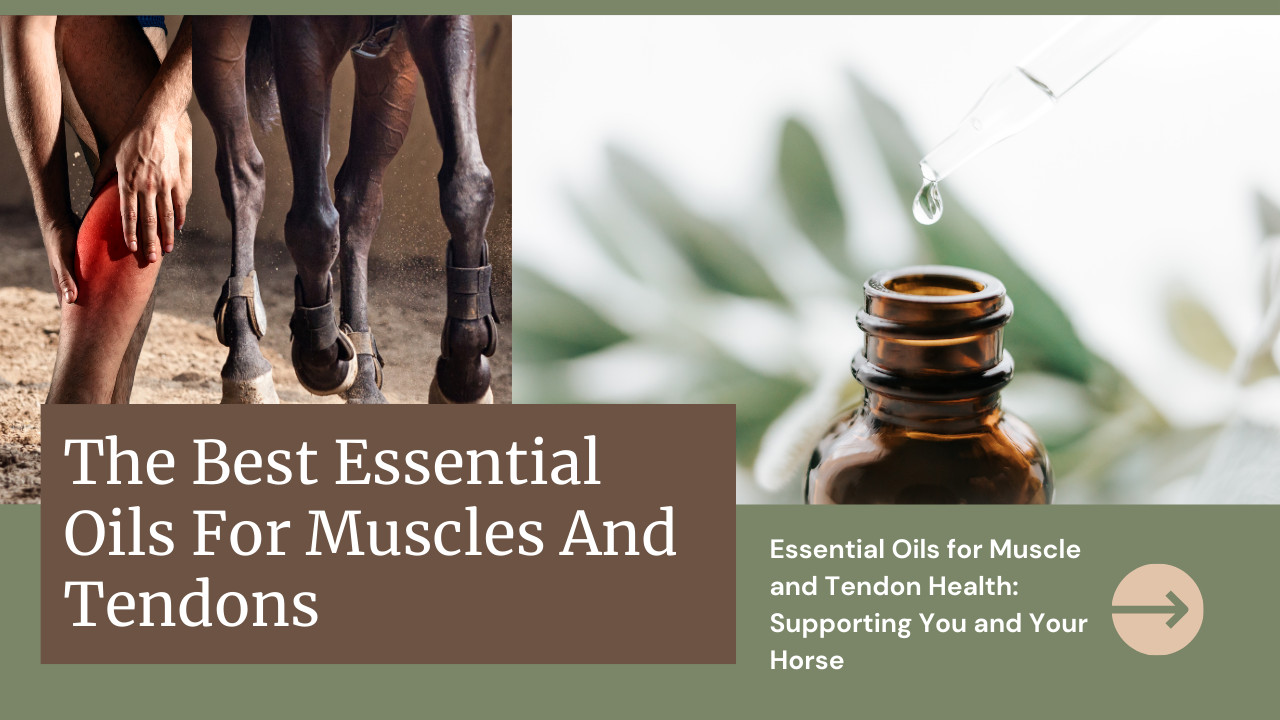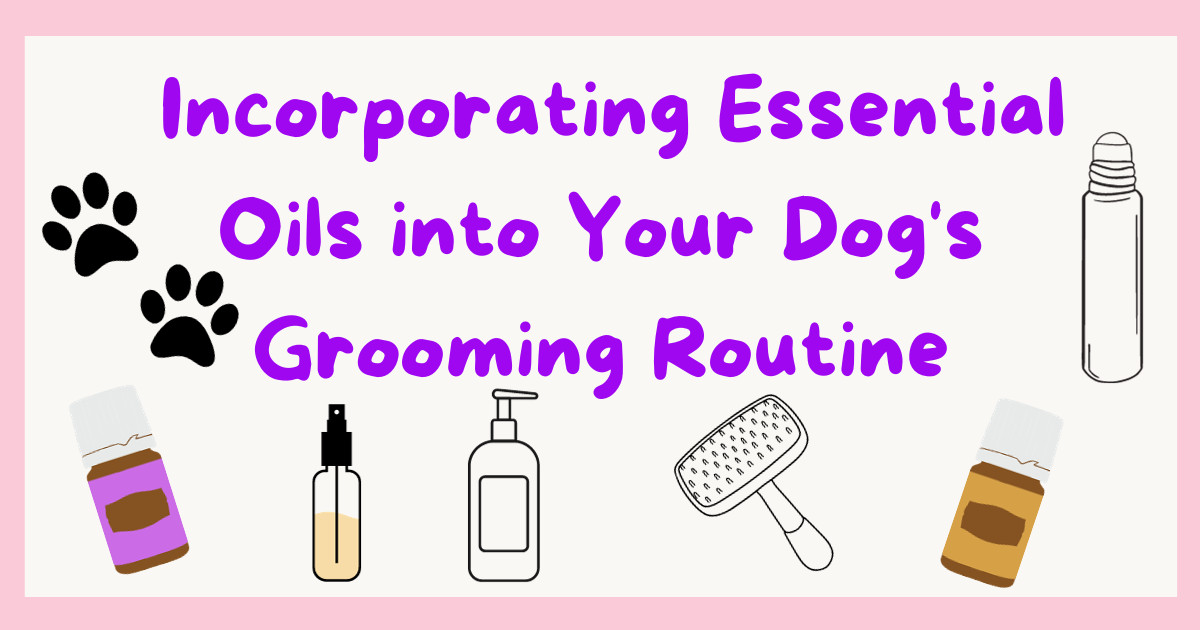
Have you ever felt the nagging pain of tendonitis, whether from riding or daily activities? As a massage therapist, I’ve frequently encountered clients struggling with this condition, which affects not only humans but also our horses. Managing tendonitis—especially with the demands of riding and caring for our equine companions—can be quite challenging. Over the years, I’ve discovered essential oils that can help to support muscle and tendon health in both people and horses.
In this blog, I’ll explore some of the top essential oils for muscles and tendons, highlighting their properties and providing useful tips for incorporating them into your routine. I’ll also touch on general care practices that can support overall musculoskeletal health.
Understanding Tendonitis and Its Impact
Tendonitis occurs when a tendon—the tough, fibrous connective tissue that connects muscle to bone—becomes inflamed or irritated. This condition can manifest in various forms, including Achilles tendonitis, tennis elbow, and tendon pain in the knees, hips, or shoulders. Tendonitis often arises from repetitive movements, overuse, or strain, leading to symptoms such as pain, stiffness, and swelling. For equestrians, activities like picking out stalls, raking, or grooming multiple horses day in and day out can lead to our own form of tennis elbow.
In my experience with horses, tendonitis can hinder their performance and cause significant discomfort. Just like in humans, tendonitis often arises from repetitive strain and overexertion. Factors such as improper shoeing, trimming, footing, and even turnout can all play a role in the development of tendonitis in horses.
Whether you’re managing your own muscle discomfort or helping a horse with tendon issues, using essential oils can be an excellent complementary approach.
Prevention is Key
To reduce the risk of developing tendonitis in both yourself and your horse, it's essential to pay attention to body mechanics and avoid overexertion. Here are some general care practices to consider for both humans and horses:
- Warm-Up and Cool Down: Always take the time to warm up before physical activity and cool down afterward. Stretching enhances flexibility and prepares tendons for movement, benefiting both you and your horse.
- Cross-Training: Engage in a variety of exercises that promote overall strength and balance, rather than focusing on repetitive activities. This approach helps prevent overuse injuries for both riders and their horses.
- Listen to Your Body and Your Horse: Be attentive to any signs of discomfort or fatigue in yourself and your horse. If you notice pain during an activity or something feels off while riding, it’s important to take a pause and investigate further.
- Strengthening Exercises: Incorporate exercises that target the muscles surrounding your tendons, as well as your horse's, to provide better support and reduce strain.
By adopting these preventative measures, you can help protect your body and maintain overall musculoskeletal health. When tendonitis does occur, incorporating essential oils into your recovery routine can further support the healing process and help to relieve discomfort.
When using essential oils, it's important to work closely with your veterinarian and medical provider, ensuring that these natural remedies support your body rather than replace professional care.
What Are Essential Oils?
Essential oils are concentrated plant extracts that capture the natural aroma and beneficial properties of various plants. Obtained through methods such as steam distillation and cold pressing, these potent oils preserve the unique characteristics of the plant material. Due to their high concentration, essential oils are incredibly effective for various applications, including physical discomfort and emotional well-being.
In addition to supporting physical health, essential oils can positively impact emotional well-being. Their aromatic properties can promote relaxation, reduce tension, and enhance mood, making them a valuable component of holistic care.
The essential oil industry is not well regulated, and many synthetic products are available on the market today, making it essential to purchase a high-quality, pure essential oil from trusted sources that you won’t find in your local supermarket or gas station. Always read labels carefully and look for the scientific name of the plant. Unless you are purchasing a pre-diluted blend, pure essential oils should contain no additional ingredients.
Avoid any product that mentions "fragrance" on the label, as this indicates it is not a true essential oil. I invite you to check out my company HERE, which controls the entire process from planting to harvesting and distillation. I've visited the farms, helped plant and distill, and even bottled my own oils. This transparency assures me of a pure and unadulterated essential oil, which is a crucial safety factor when using essential oils, especially with animals.
Dilution
Due to their high concentration—approximately 75 lemons are needed to produce one bottle of lemon essential oil—it is best practice to dilute essential oils in a carrier oil. This helps prevent skin irritation and facilitates the application of a small amount over a larger area.
To dilute an essential oil effectively, we use a carrier oil, which is a fatty oil that helps "carry" the essential oil onto the skin. Essential oils love fat, which is why we choose a fatty oil as a carrier. Carrier oils can be any vegetable oil, such as olive oil or sweet almond oil, but my personal favorite is fractionated coconut oil. This type of coconut oil remains liquid at room temperature, absorbs well into the skin, and is non-greasy—making it ideal for massage. These oils not only dilute the concentrated essential oils but also provide nourishing properties that benefit the skin. For personal use, I love creating a massage rub with fractionated coconut oil.
If you’d like to dive deeper into the benefits and uses of different carrier oils, check out my blog HERE.
While you can mix essential oils in water, keep in mind that they tend to float on the surface due to their fat-loving nature. It's important to shake the mixture well before use to ensure even distribution. For better results, it's generally recommended to add an emulsifier.
In the case of supporting muscles and tendons, I like to create a spray using half water and half witch hazel. Witch hazel has its own soothing properties and acts as an emulsifier, helping to mix the oil with water. Derived from the bark and leaves of the Hamamelis virginiana plant, witch hazel is well-known for its soothing and anti-inflammatory properties, making it a great addition to your muscle care regimen. This blend is not only easy to apply but also offers the added benefits of both the essential oils and the witch hazel, making it perfect for muscle and tendon support.
Best Essential Oils for Muscle and Tendon Recovery
Here’s a list of my favorite essential oils for muscle and tendon support that I have successfully used throughout my career. Many of these oils have also been studied for their potential analgesic (pain-relieving) and anti-inflammatory properties, which can further support muscle and tendon health. Remember, while these oils can be beneficial, they should never replace medical advice or treatment from healthcare professionals.
Peppermint Oil
Peppermint oil is renowned for its invigorating scent and cooling effect. The menthol in peppermint oil creates a cooling sensation that transitions to warmth on the skin, helping with discomfort. This unique property can help cool and soothe fatigued muscles after physical activity, making it an excellent option for supporting tendon health.
Lavender Oil
Lavender essential oil is often celebrated for its calming effects, but it also has qualities that may aid in muscle management. This study on PubMed.gov found that lavender essential oil relaxes vascular smooth muscle.
Lavender essential oil is often celebrated for its calming effects, but it also has qualities that may aid in muscle management. This study on PubMed.gov found that lavender essential oil relaxes vascular smooth muscle.
Wintergreen Oil
Wintergreen oil contains methyl salicylate, a compound recognized and studied for its analgesic properties. Research supports its effectiveness in cooling fatigued muscles and joints, making it a common ingredient in topical formulations.
Wintergreen oil contains methyl salicylate, a compound recognized and studied for its analgesic properties. Research supports its effectiveness in cooling fatigued muscles and joints, making it a common ingredient in topical formulations.
Helichrysum Italicum
Helichrysum, also known as everlasting or immortelle, has been studied for anti-inflammatory properties. A study published on PubMed.gov concludes that the anti-inflammatory activity of Helichrysum italicum can be attributed to multiple effects, including the inhibition of inflammatory enzymes, free-radical scavenging activity, and corticoid-like effects. This makes it a valuable addition to any recovery regimen.
Helichrysum, also known as everlasting or immortelle, has been studied for anti-inflammatory properties. A study published on PubMed.gov concludes that the anti-inflammatory activity of Helichrysum italicum can be attributed to multiple effects, including the inhibition of inflammatory enzymes, free-radical scavenging activity, and corticoid-like effects. This makes it a valuable addition to any recovery regimen.
Sweet Marjoram
Sweet marjoram oil has constituents that are mentioned in this study on PubMed.gov for their analgesic and antispasmodic properties, making it one of my top choices for all things muscle and tendons. Its warm, comforting scent can also promote relaxation.
Rose Geranium
Rose geranium oil not only offers a delightful fragrance but also has been studied for its antioxidant effects. A study assessing neuropathic pain relief with topical geranium oil found that "geranium oil treatment was associated with a significant reduction in pain." This highlights its potential in managing discomfort.
Cypress Oil
Cypress essential oil is particularly recognized for its supportive role in the circulatory system, making it one to reach for during muscle and tendon injuries. Its uplifting aroma can also help relieve feelings of tension and promote a sense of well-being, enhancing your recovery experience.
Copaiba Oil
Copaiba oil has gained recognition for its primary constituent, beta-caryophyllene, which has been studied for its anti-inflammatory and analgesic properties. A pain relief assessment highlighted HERE on PubMed.gov, indicated positive results, noting that the blended essential oils used contained key analgesic compounds like linalyl acetate, linalool, eucalyptol, and beta-caryophyllene. I often reach for copaiba to support the healing process during periods of discomfort.
Grand Fir Oil
Grand fir oil is known for its ability to promote relaxation and may assist with muscle tension. A research study published on PubMed.gov aimed to clarify the potential anti-inflammatory action of one of its constituents and reported positive results.
To use these essential oils, simply add a few drops of essential oil to a dollop of carrier oil in your palms. Rub them together, then gently massage the mixture onto the desired area.
Alternatively, you can create a blend of essential oils to enhance their effects. Below is one of my favorite simple DIY recipes for a muscle and tendon blend:
Muscle and Tendon Spray Recipe
Ingredients:
- 1 ounce witch hazel
- 1 ounce distilled water
- 4 drops peppermint essential oil
- 4 drops wintergreen essential oil
- 4 drops copaiba essential oil
- 4 drops cypress essential oil
- 4 drops grand fir essential oil
Instructions:
- Add the essential oils to a 2 ounce spray bottle, glass or high quality chemically resistant plastic.
- Add the ounce of witch hazel and then the distilled water.
- Secure the lid and shake well to combine. while witch hazel helps emulsify the essential oils in the water you still want to shake well each time before you spray.
- Spray onto the desired area as needed, avoiding contact with eyes and open wounds.
Massage Oil Recipe
For a relaxing and effective massage rub to support muscle and tendon health, try this simple recipe:
Ingredients:
- 1 cup fractionated coconut oil
- 5 drops helichrysum essential oil
- 5 drops copaiba essential oil
- 5 drops peppermint essential oil
- 5 drops wintergreen essential oil
- 10 drops lavender essential oil
- 5 drops sweet marjoram essential oil
- 5 drops cypress essential oil
To prepare the massage rub, add the essential oils to an 8-ounce high-quality plastic squirt container. Next, fill the container with fractionated coconut oil and invert it back and forth several times to mix thoroughly. When you’re ready to use the rub, gently massage it into the desired area.
General Recovery Tips for Tendonitis
In addition to using essential oils, consider these general tips to support muscle and tendon recovery:
- Avoid Overuse: Overuse is one of the most common causes of tendon problems. Repetitive movements without proper rest can cause inflammation and irritation. Be mindful of your activities, and take regular pauses to prevent excessive strain on your tendons. If you experience discomfort or fatigue, modify your activities to reduce the risk of exacerbating the issue.
- Rest and Ice: Apply ice packs to the affected area to reduce swelling and inflammation. Adequate rest is also crucial for healing.
- Nutrition: Nutrition plays a vital role in muscle and tendon recovery, yet it is often overlooked. Supplementation of essential fatty acids, vitamin C, and vitamin E to support tissue repair may be helpful. Additionally, collagen has emerged as a valuable supplement for supporting tendon health. Collagen is a crucial protein that provides structure to tendons, and supplementation may enhance repair and regeneration, improve strength, and reduce pain associated with injuries.
- Massage: Regular massage can be highly beneficial for maintaining muscle flexibility and reducing tension. Since muscles connect to tendons, keeping them loose and relaxed helps support the tendons and can alleviate strain on these critical structures. Consider incorporating self-massage techniques or seeking professional help to ensure optimal muscle health.
- Physical Therapy: Work with a physical therapist to identify any imbalances and develop a targeted routine to support the affected tendon. A tailored rehabilitation plan can significantly enhance recovery and prevent future issues.
- Feldenkrais Work: Feldenkrais is a movement-based approach designed to improve physical function and awareness through gentle, mindful movements. It focuses on re-educating the nervous system to promote better movement patterns and reduce tension. By exploring new ways of moving, individuals can address imbalances and limitations that may contribute to tendon issues. This method can enhance overall body awareness and improve flexibility, aiding in the recovery process.
For horses, ensuring that shoeing or trimming is appropriate is crucial for maintaining tendon health and preventing injuries. For example, long toes can lead to an incorrect breakover point, which may cause the horse to overreach or land awkwardly, increasing the risk of tendon injuries.
Additionally, it's important to look for any underlying gait abnormalities that may be causing uneven wear or stress on the tendons. Regular assessments of your horse’s movement can help identify these issues early. The footing you ride on also plays a significant role in tendon health; uneven or overly soft or hard surfaces can increase the risk of injury.
To further support tendon health, consider icing your horse’s legs after intense workouts or competitions. This can help reduce swelling and inflammation, acting as a preventative measure against tendonitis.
Furthermore, consider using support equipment such as wraps and boots to protect the lower legs during work, turn out, or travel. These tools can provide extra support, stabilize the tendons, and help prevent injuries, ultimately contributing to your horse’s overall well-being.
Recovering from tendonitis takes time, and everyone’s healing journey is unique. Using essential oils as part of a comprehensive recovery plan can enhance your experience. By supporting the circulatory system and reducing discomfort, these natural remedies can play a role in wellness.
If you’d like to get your hands on these essential oils, I invite you to click the link HERE. I’ve created a bundle of these oils along with a carrier oil, so you’ll have everything you need to get started right away. You can simply pick and choose which ones resonate with you and add them to your cart. This is an affiliate link at no cost to you, but it helps support my small business. Thank you for your support!











0 Comments